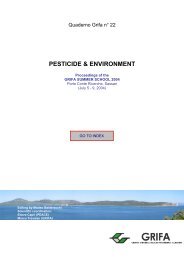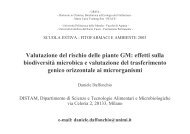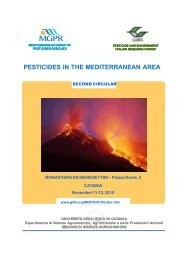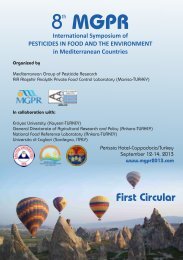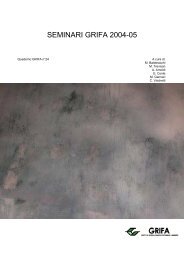International Congress BIOLOGICAL PRODUCTS - Gruppo di ...
International Congress BIOLOGICAL PRODUCTS - Gruppo di ...
International Congress BIOLOGICAL PRODUCTS - Gruppo di ...
Create successful ePaper yourself
Turn your PDF publications into a flip-book with our unique Google optimized e-Paper software.
Obtained recoveries percent were: 84.5±9.9% for Cd, 97.3±2.7% for Cu, 1 00.7±0.7 % for Pb and 83.4±1.7 % for<br />
Zn. Instrumental detection limits were: 1.2 ngg -1 for Cd, 3.6 ngg -1 for Cu, 5.9 ngg -1 for Pb and 14.3 ngg -1 for Zn.<br />
Application<br />
Obtained results are reported on Table 1. Cd (II) was not found in any olive oil sample. The highest<br />
content of Cu (II) was found in the sample originated from biological strategy (96.1±5.3 ng g -1 ). A lower<br />
content of the metal was presented by the samples produced from plants treated with organic pesticides<br />
associated or not to copper oxy-chlorine, such as copper oxy-chlorine/<strong>di</strong>methoate (91.4±5.1 ng g -1 ) and copper<br />
oxy-chlorine/fenthion (60.0±3.1 ng g -1 ). A smaller level of Cu was found in samples originated from<br />
<strong>di</strong>methoate/fenthion (56.8±3.3 ng g -1 ), <strong>di</strong>methoate (38.3±0.4 ng g -1 ) and no treated sample (44.8±1.5 ng g -1 ).<br />
The smallest Cu concentration was found in the oil originated from copper oxy-chlorine treatment (26.0±2.3 ng<br />
g -1 ).<br />
Oil samples produced from olive grove treated with organic pesticides - copper oxychlorine/fenthion<br />
(222.6±2.3 ng g -1 ), <strong>di</strong>methoate (179.2 ±1.9 ng g -1 ), <strong>di</strong>methoate/fenthion (165.0±1.5 ng g -1 ) - showed a higher<br />
lead amount respect to samples treated only with copper oxy-chlorine (47.5±0.5 ng g -1 ), no-treated sample<br />
(34.6±0.4ng g -1 ) and the sample from biological strategy (17.3±0.2 ng g -1 ), which presented the lowest Pb<br />
content (fig.1). An exception was represented by the sample treated with copper oxy-chlorine/<strong>di</strong>methoate<br />
(32.8±0.3 ng g -1 ).<br />
Samples produced from olive groves treated with copper oxy-chlorine/fenthion (576.0±6.3 ng g -1 )<br />
presented the highest content of Zn, followed by biological strategy (550.0±5.8 ng g -1 ) and copper oxychlorine/<strong>di</strong>methoato<br />
(433.2±4.7 ng g -1 ) samples; the oils treated with <strong>di</strong>methoate (176.0 ±1.9 ng g -1 ), copper<br />
oxy-chlorine (161.5±1.7 ng g -1 ), <strong>di</strong>methoate/fenthion (140.8±1.5 ng g -1 ), showed a Zn level remarkably<br />
lower. The smallest concentration of the metal was found in no-treated sample (59.8±0.7 ng g -1 ).<br />
CONCLUSION<br />
Samples produced from no treated olive grove and by plants treated only with copper oxy-chlorine,<br />
always showed a lower content of Cu (II), Pb (II) and Zn (II) respect to samples originated from olive grove<br />
treated with the organophosphorated pesticides <strong>di</strong>methoate and fenthion. These molecules, which contain S, P<br />
and O atoms, may influence the mechanism of metals uptake of the plants by complexing the cations (10).<br />
Samples originated from biological fight always present a high amount of the micronutrient Cu (II) and Zn (II)<br />
and a very low concentration of Pb (II).<br />
LITERATURE<br />
1. Martín-Polvillo M., Albi T. and Guinda A. Determination of trace elements in e<strong>di</strong>ble vegetable<br />
oils by atomic absorption spectrophotometry. J. Am. Oil Chem. Soc. 1994, 71, 347-350.<br />
2. Calapaj R., Chiricosta S., Saija G. and Bruno E. Method for the determination of heavy metals<br />
in vegetable oils by graphite furnace atomic absorption. At. Spectrosc. 1988, 9, 107-110.<br />
3. Paoletti R., Nicosia S., Clementi F., Fumagalli G. 1 st ed. “Tossicologia degli alimenti”, 1999,<br />
Utet, Torino.<br />
4. De Leonar<strong>di</strong>s A., Macciola V. and De Felice M. 1997. La determinazione del ferro e del rame<br />
negli oli vergini d'oliva me<strong>di</strong>ante spettrofotometria ad assorbimento atomico. Riv. Ital. Sostanze Grasse 74:<br />
149.<br />
5. Garrido M.D., Frías I., Díaz C. and Har<strong>di</strong>sson A. Concentrations of metals in vegetable e<strong>di</strong>ble<br />
oils. Food Chem. 1994, 50, 237-240.<br />
6. Wahdat F., Hinkel S. and Neeb R. Direct inverse voltammetric determination of Pb, Cu and Cd<br />
in some e<strong>di</strong>ble oils after solubilization. Fresenius' Z. Anal. Chem. 1995, 352, 393-396.<br />
7. La Pera L., Lo Curto S., Dugo G.mo, Lo Coco F. and Liberatori A. Determination of Copper<br />
(II), lead (II), cadmium (II) and zinc (II) in olive oils from Sicily by derivative potentiometric stripping<br />
analysis (dPSA). Presented at “European Conference of Advanced Technology for Safe and High Quality of<br />
Food”, Berlin, 5-7 December, 2001.<br />
8. La Pera L., Lo Curto S., Visco A., La Torre L. and Dugo G.mo Derivative potentiometric<br />
stripping analysis (dPSA) used for the determination of cadmium, copper, lead and zinc in Sicilian olive<br />
oils. J. Agric. Food Chem. 2002, 95, 3090-3093.<br />
9. La Pera, L.; Lo Coco, F.; Mavrogeni, E; Giuffrida, D.; Dugo, G.mo. Determination of Copper<br />
(II), Lead (II), Cadmium (II) and Zinc (II) in virgin olive oils produced in Sicily and Apulia by Derivative<br />
Potentiometric Stripping Analysis. Ital. J. Food Science 2002 in press.<br />
10. Kaim W.; Schwedersky B. Bioinorganic Chemistry: inorganic elements in the chemistry of<br />
life. V th ed. Wiley & Sons Ltd, West Sussex, England, 1996.<br />
PDF creato con FinePrint pdfFactory versione <strong>di</strong>mostrativa http://www.secom.re.it/fineprint<br />
95



